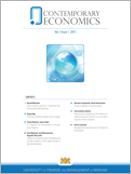Consolidation and Legacy of Foreign Currency Household Lending in Central and Eastern Europe: The Case of Hungary
Consolidation and Legacy of Foreign Currency Household Lending in Central and Eastern Europe: The Case of Hungary
Author(s): Pál P. Kolozsi, Csaba LentnerSubject(s): Financial Markets, Public Finances, Fiscal Politics / Budgeting
Published by: Akademia Ekonomiczno-Humanistyczna w Warszawie
Keywords: mortgage loans; financial stability; monetary policy; debt consolidation; conversion; CEE; macroprudential policy:
Summary/Abstract: During the first decade of the 21st century, household FX loans spread in numerous countries in Central and Eastern Europe, where they caused serious macroeconomic and social problems with the spillover of the global financial crisis. Disregarding countries that joined the euro area, Hungary was the only state where household FX loans were completely phased out. The aim of the paper is to provide a structured presentation of the circumstances of the FX loan conversion in Hungary and to assess the potential risks related to the post FX loan period. The paper reviews the relevant international literature about the causes and the impact of unsecured FX lending in the household sector and analyses the phasing-out of the household FX loans in Hungary from the point of view of the legal considerations, the interest rate environment, the macroeconomic stability, the elbowroom in FX reserves and the timing of the process. The paper concludes that the conversion happened at the first date which was legally allowed and economically properly underpinned. The paper also presents that the central bank reacted to the new challenges of the phasing-out process with new macroprudential tools to prevent excessive indebtedness and over-lending, to reduce households' interest rate risks, and to ensure that customers have appropriate income reserves, in order to improve the quality and sustainability of lending to households in the future.
Journal: Contemporary Economics
- Issue Year: 14/2020
- Issue No: 3
- Page Range: 366-378
- Page Count: 13
- Language: English

